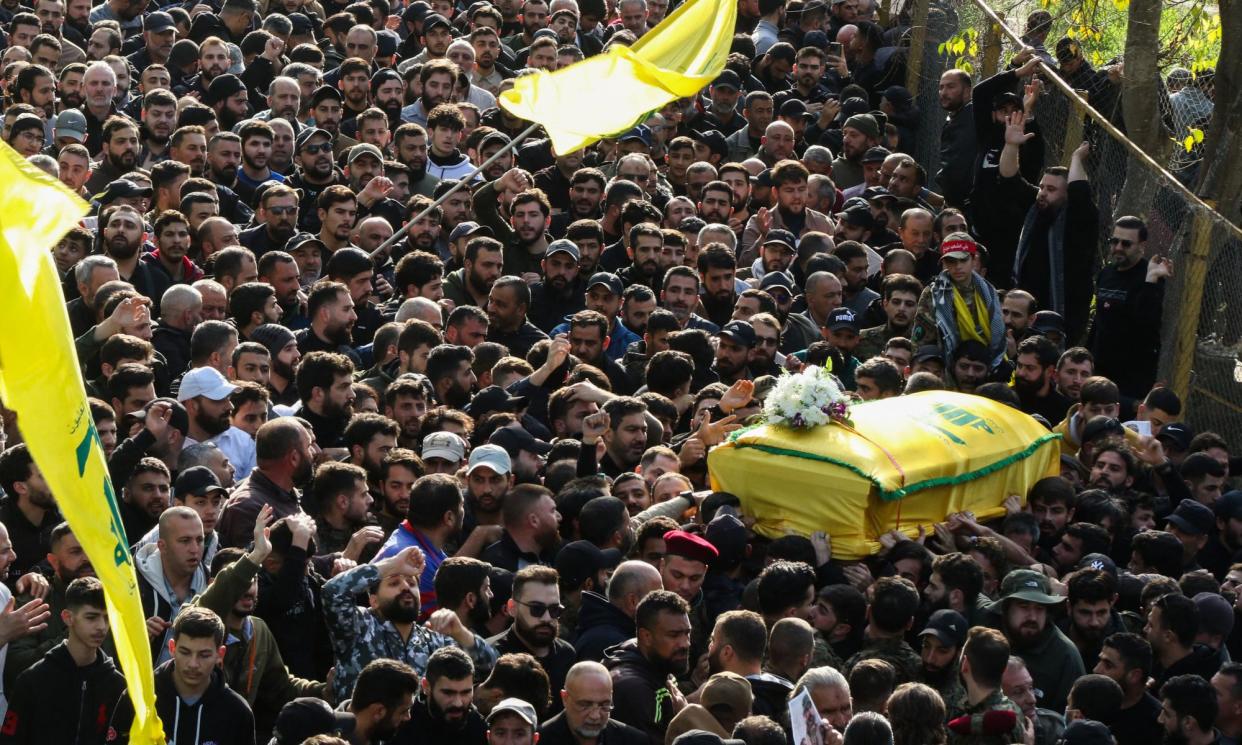Iran’s ‘axis of resistance’ is a potent coalition but a risky strategy

The “axis of resistance” is a network of autonomous militant Islamist groups through which Iran can project power, determine the course of events and deter attack by Israel or the US. The axis is so central to the current conflict that on 7 October, as the bloody attack on Israel was still under way, Hamas’s military commander called on the network to join the struggle. “Our brothers in the Islamic resistance in Lebanon, Iran, Yemen, Iraq and Syria, this is the day when your resistance unites with your people in Palestine,” Mohammed Deif said in an audio message.
Since then, those allies have joined a much broader regional conflict, with varying enthusiasm. Together they constitute a very potent and unconventional coalition. Its roots lie in the Iranian Revolution of 1979, which brought to power radical Shia Muslim clerics keen on exporting their brand of extremism across the Islamic world.
Early efforts brought patchy success – but more recently chaos in Syria, Iraq and Yemen opened new opportunities for expansion. So too growing unrest among Palestinians in the occupied West Bank and Gaza.
The current crisis marks the first time the axis has mobilised on multiple fronts. Most experts believe Iran wants to fight the US and Israel without entering into direct conflict. This may limit violence but will not end it. It is a risky strategy: the slightest miscalculation by any actor could trigger an unstoppable regional conflagration.
Hezbollah
Hezbollah, founded in the early 1980s in Lebanon, is the biggest and most capable member of the “axis of resistance”. It has formidable ground forces that have proven their ability to hurt Israel in open warfare, and its huge arsenal of rockets could strike almost anywhere in its enemy’s territory. It has popular support among Lebanon’s large Shia population, is deeply involved in Lebanon’s politics and has substantial economic interests.
Since Israel’s offensive, Hezbollah has engaged in its heaviest clashes for almost 20 years. Around 15 Israelis, mostly soldiers, have been killed by missiles fired into Israel, and about 150 Hezbollah militants, including senior commanders, have died in Israel’s retaliatory airstrikes and shelling.
But, though deeply concerned by the escalation on their disputed northern border, Israeli officials still believe Hezbollah’s leadership fears the cost of an outright war and will seek to limit any escalation.
Hamas
Hamas is less close to Tehran than Hezbollah. It grew out of a Sunni tradition of extremist Islamism which long predates the Iranian revolution and has been based in Gaza since its foundation in 1987 after the first Palestinian intifada.
It has long had a “marriage of convenience” with Iran, albeit with multiple disputes. Tehran has supplied funding, weapons and expertise. After tensions over the Syrian civil war, relations have recently improved.
The 7 October attacks made the limits to the relationship very clear, however. Tehran was not warned in advance about what was probably the most significant single use of violence by any of its proxies for decades, and it struggled to formulate a coherent strategic response. The Israeli offensive in Gaza is aimed at “crushing Hamas”, and will dramatically reduce its capabilities. It may not destroy the group entirely, however.
The smaller Palestinian Islamic Jihad faction is considered closer to Iran, joined the 7 October attacks and has expanded recently in the occupied West Bank.
The Houthis
The Houthis, a Yemeni militia, emerged in the 1980s and are named after founder Hussein Badreddin al-Houthi. They represent a minor branch of Shia Islam, which, with their hatred of Saudi Arabia, makes them natural allies of Iran. Its estimated 20,000 fighters run most of the west of Yemen and control its Red Sea coastline.
The Houthis have fought and largely won a nine-year civil war against Yemen’s government — which is supported by Riyadh. They are thought to be one of the members of the axis of resistance most closely controlled by Iran.
Soon after the 7 October attacks, their leader said his forces were “ready to move in the hundreds of thousands to join the Palestinian people”. Such rhetoric is popular locally.
Shortly after the start of the Gaza war, the Houthis began launching missile and drone attacks on vessels in the Red Sea and towards Israel. Most were intercepted by US and Israeli countermeasures, but the attacks on shipping escalated to a point where Washington felt it had to retaliate.
Iraqi and Syrian militias
From almost the start of the war in Gaza, Iran-backed militias have targeted US forces on often-remote bases in Iraq and Syria. The militias were established in the chaos following the US invasion of Iraq in 2003 and then during the Syrian civil war. They have several aims: to project Iranian influence, to bolster allies and to resist western plans for the region. Though now less numerous, the many factions across the two countries have often proved a cheap and useful tool for Tehran.
Attacks by these militia have not killed anyone directly, but have caused numerous injuries to US troops. Washington’s response has escalated, drawing the US further into the regional conflict President Joe Biden hopes so much to avoid.


